Rain Stops 2nd NZ‑AUS T20I, Australia Retains Chappell‑Hadlee Trophy
Rain halted the 2nd NZ‑AUS T20I, letting Australia retain the Chappell‑Hadlee Trophy as the third match unfolds. Key performances and series stakes explained.
When talking about T20 International, the 20‑over per side version of men’s and women’s international cricket governed by the ICC. Also known as Twenty20 International, it blends explosive batting, tight bowling and fast‑moving fielding into a game that finishes in about three hours.
The broader sport of cricket, a bat‑and‑ball game played on a circular or oval field with two teams of eleven players provides the foundation for T20 International. While Test cricket can stretch over five days, the T20 format demands a high strike rate from batters, meaning they aim to score more than 150 runs per 100 balls on average. Bowlers, on the other hand, chase a low economy rate, often below eight runs an over, to keep the scoreboard in check.
The International Cricket Council (ICC), the global governing body that sets rules, schedules tournaments and ranks teams oversees every T20 International match. It decides the official status of a game, publishes the T20 ranking tables and organises flagship events like the T20 World Cup. Because the ICC controls the calendar, teams know when they can face each other, and fans can plan around set series and tournaments.
One of the most watched events is the T20 World Cup, a quad‑annual competition where the top international sides battle for the world title in the Twenty20 format. The tournament showcases the highest strike rates, inventive bowling variations and dramatic finishes that define the format. Performances in the World Cup often boost a player’s market value, leading to contracts in lucrative franchise leagues such as the IPL and the Big Bash.
Beyond the marquee tournaments, the T20 International calendar also includes bilateral series, regional qualifiers and occasional emergency fixtures when weather or travel disrupts plans. These matches give emerging nations a chance to earn official status and climb the rankings. For a fan, this steady flow of games means there’s always fresh data—batting averages, strike‑rate trends, bowling figures—to chew on.
What ties all these pieces together is the need for adaptable skills. Batters must master power‑hitting, rotate the strike and finish games under pressure. Bowlers juggle pace, spin and variation to limit runs in a short spell. Fielders sharpen reflexes because a single misfield can change the outcome in a game that lasts just three hours. In short, the T20 International format demands a blend of raw talent and strategic acumen.
Below you’ll find a curated collection of articles that break down recent matches, analyse player performances, and explain how the format evolves. Whether you’re looking for a quick recap of the latest series, a deep dive into strike‑rate statistics, or insight into how the ICC shapes the T20 landscape, the posts ahead have you covered. Dive in and discover the stories that make T20 International cricket such a thrilling spectacle.

Rain halted the 2nd NZ‑AUS T20I, letting Australia retain the Chappell‑Hadlee Trophy as the third match unfolds. Key performances and series stakes explained.